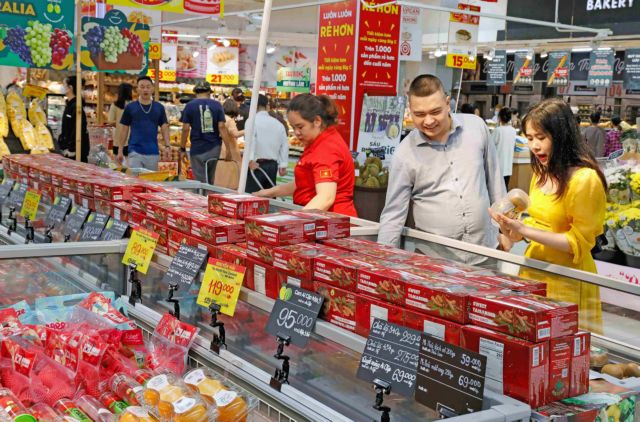 Economy
Economy


|
| Director of the General Statistics Office Nguyễn Thị Hương |
After three years impacted by the COVID-19 pandemic, the Vietnamese economy has witnessed robust growth from the beginning of this year. The gross domestic product (GDP) expanded at 8.83 per cent in January-September and was expected to beat the target of 6-6.5 per cent set for the full year to reach 7.5-8 per cent.
Still, it remained challenging for the Southeast Asian country to meet the growth target of 6.5-7 per cent for the whole 2021-25 period, which meant that the average annual growth would have to reach 7.4-7.5 per cent for the remaining years.
Director of the General Statistics Office Nguyễn Thị Hương spoke to Việt Nam News Agency about the economic landscape this year and growth prospects in the context of a global slowdown.
What are the forecasts for the global economy this year?
Many international organisations have recently lowered their forecasts for global economic growth in 2012 by around 0.5-1.4 percentage points. Challenges will remain for the global economy in 2023 with forecasts about continued slowdown and increasing recession risk in the short term, high inflation coupled with geopolitical issues, armed conflicts, natural disasters and epidemics.
In the 2015-19 period, the global economy achieved an average growth rate of 3.2 per cent. However, due to the impacts of the COVID-19 pandemic and the Russia-Ukraine conflict, the average growth of the global economy is forecast at around 1.6-1.8 per cent, equivalent to just half of the previous period’s average.
Specifically, global GDP fell by 3.3 per cent in 2020 but expanded at 5.8 per cent in 2021 and is expected to grow by 2.4-3.2 per cent this year.
In 2020, most countries saw drops in GDP, such as Spain by 10.8 per cent, the UK by 9.3 per cent, Italy by 9 per cent, France by 7.9 per cent, Canada by 5.2 per cent and the US by 3.4 per cent.
After the COVID-19 pandemic was brought under control in many countries, global production and trade recovered significantly in 2021. The global GDP increased by 5.8 per cent in that year. Countries which saw large reductions in 2020 saw considerable growth in 2021 such as Spain by 5.1 per cent, the UK by 7.4 per cent, Italy by 6.6 per cent, France by 7 per cent, Canada by 4.6 per cent and the US by 5.7 per cent.
Entering 2022, the COVID-19 pandemic has not ended and the armed conflict between Russia and Ukraine caused shortages of energy, food and essential goods for production and consumption.
Therefore, the world economy is forecast to expand at only 2.4-3.2 per cent this year, 1.1-1.5 percentage points lower than previous forecasts.
The World Bank lowered its forecast for global GDP from 4.1 per cent in early 2022 to 2.9 per cent in September.
Fitch Ratings also projected global GDP growth at 2.4 per cent, 1.1 percentage points lower than its forecast in March.
The International Monetary Fund in its World Economic Outlook forecast global growth to slow to 3.2 per cent this year, 1.2 percentage points lower than its forecast in January.
The Organisation for Economic Co-operation and Development even projected global growth at just 3 per cent, 1.5 percentage points lower than its forecast in December 2021.
The Vietnamese economy is recovering and regaining growth momentum after three years hit by the COVID-19 pandemic. In your opinion, what are the growth drivers in the past nine months?
The Vietnamese economy is recovering quickly after three years wreaked by the COVID-19 pandemic, energy, food and financial crises. Optimistic forecasts of international organisations about the Vietnamese economy clearly reflect the country’s robust economic recovery.
Positive results are reported in all fields, from agriculture, industry, construction to services. Agricultural production maintained a growth rate of 3 per cent and helped ensure food security, people’s living standards, put inflation under control and promote exports.
Industrial production posted impressive growth of 12.9 per cent in the third quarter of this year and 9.4 per cent for the January – September period. The manufacturing and processing industry rose by 10.6 per cent with good exports. Power generation also increased which ensured supply sources for production and business.
The service sector which was heavily hit by the COVID-19 pandemic recovered quickly since the third quarter of last year.
These paint a bright picture of Vietnamese economy in January – September period.
The growth drivers were largely the strong increase in the domestic aggregate demand coupled with the Government’s timely and efficient policies and solutions.
In the context of complicated global developments, what are your forecasts for the GDP growth of Việt Nam in 2022?
Achieving the growth target this year is within reach as the foundation for growth remains.
Along with that, the economic recovery package will be strongly implemented in the last quarter in the context that agriculture, service and manufacturing industries still have plenty of room for growth.
However, the impacts of global economic development are unpredictable and the geopolitical situation remains complicated, which together with the occurrence of natural disasters and inflation, will cause global demand to decline and Việt Nam’s exports might be affected. As the Vietnamese economy has high openness, the global economy will have both direct and indirect effects on all activities from production to the daily life of people.
I, however, believe that the flexibility of the Government in running the economy and the consensus of the people and enterprises, Vietnamese economy will continue to be consolidated and maintained to make good use of the internal resources and production and export capacities. On that basis, a GDP growth rate of 7.5 – 8 per cent in 2022 is within reach.
2023 is an important year in the implementation of the socio-economic development plan for the 2021-25 period. What should be the focus for Việt Nam to achieve the growth target of 6.5-7 per cent?
The global economy is forecast to slow down in 2023 with the highest risk of a recession in the short term. High inflation, geopolitical conflicts, and adjustment of policies of major economies are factors which bring risks to the stability of the financial and monetary markets, energy security, and food security. Natural disasters, climate change and diseases are more and more difficult to predict.
In the 2015-19 period, Việt Nam achieved an average annual growth rate of 7.09 per cent. The GDP growth rates were just 2.87 per cent and 2.56 per cent in 2020 and 2021, respectively, due to the impacts of COVID-19. Entering 2022, the economy is recovering strongly with a GDP growth of 8.83 per cent in the first nine months and it is expected to reach 7.5-8 per cent this year, beating the target set at 6-6.5 per cent.
However, the average growth rate in the 2020-22 period was just around 4.28-4.45 per cent, much lower than average of the previous five-year period at 7.09 per cent.
The General Statistics Office raised two scenarios for economic growth in the 2021-25 period.
In the first scenario, GDP growth reaches 7.5 per cent in 2022, which means that the economy expands at an average of 5 per cent per year in the 2021-22 period. To achieve the target of 6.5 per cent growth for the 2021-25 period, Việt Nam must reach a GDP growth of 7.51 per cent per year in the next three years.
In the second scenario, if GDP growth reaches 8 per cent in 2022, the Vietnamese economy will need to expand at 7.35 per cent per year in 2023-25 to achieve the growth target.
In both scenarios, Việt Nam must expand at around 7.4-7.5 per cent per year in the next three years. It is challenging.
2023 is an important year for the implementation of the five-year socio-economic development plan and to mark a milestone in the affirmation of Việt Nam’s position when the country’s population reaches the threshold of 100 million and the economy's size at VNĐ10 quadrillion.
Therefore, Việt Nam needs to focus on making the most of the country’s internal resources, take advantage to attract investment inflow and every opportunity to participate in global value chains. VNS









